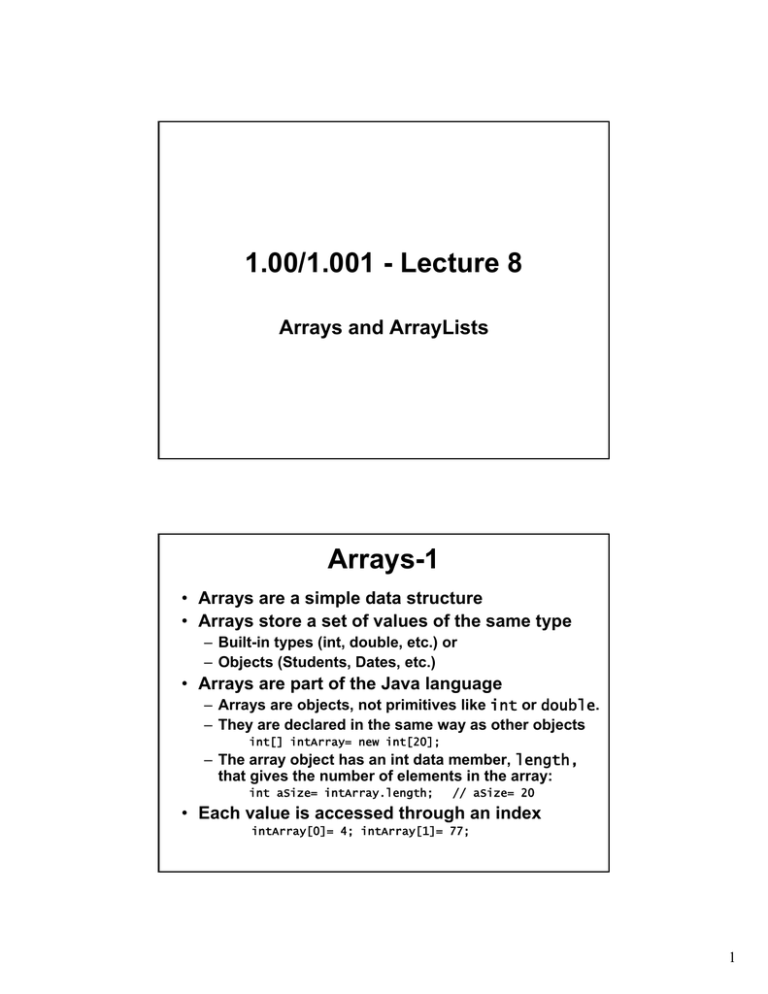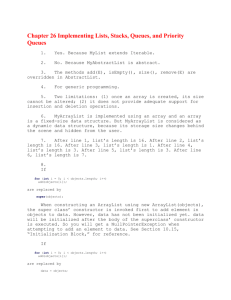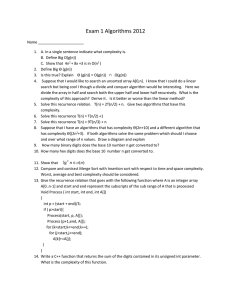1.00/1.001 - Lecture 8 Arrays-1 Arrays and ArrayLists
advertisement

1.00/1.001 - Lecture 8
Arrays and ArrayLists
Arrays-1
• Arrays are a simple data structure
• Arrays store a set of values of the same type
– Built-in types (int, double, etc.) or
– Objects (Students, Dates, etc.)
• Arrays are part of the Java language
– Arrays are objects, not primitives like int or double.
– They are declared in the same way as other objects
int[] intArray= new int[20];
– The array object has an int data member, length,
that gives the number of elements in the array:
int aSize= intArray.length;
// aSize= 20
• Each value is accessed through an index
intArray[0]= 4; intArray[1]= 77;
1
Arrays, p.2
– Array index always starts at 0, not 1
• An array with N slots has indices 0 through N-1
• intArray has elements intArray[0] through intArray[19]
– Array lengths cannot be changed once they are declared
– Arrays can be initialized when declared
int[] intArray= {5, 77, 4, 9, 28, 0, -9}; // Note that ‘new’ is implicit (not needed) in this case
– Arrays of numerical values are zero when
constructed
Copying Arrays
– To copy an array, use arraycopy( ) method of System
class, as in the following (assuming intArray exists)
int[] newArray= new int[intArray.length]
// arraycopy(fromArray, fromIndex, toArray, toIndex, count)
System.arraycopy(intArray, 0, newArray, 0, intArray.length);
// Now intArray and newArray have separate copies of data
Note: Arrays don’t have to be same length as long as segment
copied fits into destination array
2
Copying an array reference
– If we had just defined newArray
without copying:
int[] newArray= intArray;
newArray[2]= -44;
// This sets
// intArray[2]= -44 also
// intArray and newArray would
// be two names for the
// same array. Remember in Java
// references refer to objects
Copying reference to array
intArray
5
77
int[ ] intArray= {5, 77, 4, 9, 28, 0, 9};
int[ ] newArray = intArray;
4
newArray
9
28
0
9
3
Copying entire array
int[ ] intArray= {5, 77, 4, 9, 28, 0, 9};
int[ ] newArray = new int[intArray.length];
System.arraycopy(intArray,0,newArray,0,intArray.length)
intArray
5
77
newArray
5
77
4
4
9
9
28
28
0
9
0
9
Looping Over Array
• Java 1.5 introduced new way of
looping over a collection.
• If arrDouble is a reference to array of
doubles, the “old” way is:
double sum = 0.0;
for(int i=0; i<arrDouble.length; i++)
sum = sum + arrDouble[i];
4
Looping Over Array – Java 1.5
In Java 1.5, we can loop over elements of a
collection as follows:
double sum = 0.0;
for(double d : arrDouble)
sum = sum + d;
Multidimensional Arrays
– You can create 2, 3, ..n dimensional
arrays in Java.
int[ ][ ] twoDArray = new int[5][10];
A 2D array is actually an array of 1 D
arrays, so that
twoDArray[3][5]
Refers to the sixth element of the fourth
array of integers.
5
Test Your Knowledge
1. Which of
of the follow
following expre
declare and
expressions
ssions does not de
construct an array?
a. int[ ] arr = ne
new
w int[4];
b. int[ ] arr;
arr;
arr = new int [4];
[4];
c. int[ ] arr = {1,2,
{1,2,3
3,4};
d. int[ ] arr;
2. Given this code fragm
fragme
ent:
int j= ?;
?;
int[10];
int[] data = new int[10];
System.out.print(data[ j ]);
Which of the following is a legal value of j?
a. -1
b. 0
c. 1.5
d. 10
Test Your Knowledge
1. Which o
off the follo
follow
wing expre
expressions
ssions does not d
de
eclare and
construct an array?
a. int[ ] arr = ne
new
w int[4];
b. int[ ] arr;
arr;
arr = new int [4];
[4];
c. int[ ] arr = {1,2,
{1,2,3
3,4};
d. int[ ] arr;
2. Given this code fragm
fragme
ent:
int j= ?;
?;
int[] data = new int[10];
int[10];
System.out.print(data[ j ]);
]);
Which of the following is a legal value of j?
a. -1
b. 0
c. 1.5
d. 10
6
Test Your Knowledge
3. Given this code fragment:
int[] arrayA = new int[4];
int[] arrayB;
arrayB = arrayA;
arrayB[2]=4;
arrayA[0]=arrayB[2];
4. How many objects are present after
the following code fragment has
executed?
float[] arrayA = new float[10];
float[] arrayB;
arrayB = arrayA;
What are the values of
the elements in array A?
a. unknow
unknown
b. 0,0,0,
0,0,0,0
c. 4,0,
4,0,4,0
d. 4,0,0,
4,0,0,0
a. 1
b. 2
c. 10
d. 20
Test Your Knowledge
3. Given this code fragment:
int[] arrayA = new int[4];
int[] arrayB;
arrayB = arrayA;
arrayB[2]=4;
arrayA[0]=arrayB[2];
4. How many objects are present after
the following code fragment has
executed?
float[] arrayA = new float[10];
float[] arrayB;
arrayB = arrayA;
What are the values of
the elements in array A?
a. unknow
unknown
b. 0,0,0,
0,0,0,0
c. 4,0,
4,0,4,0
d. 4,0,0,
4,0,0,0
a. 1
b. 2
c. 10
d. 20
7
Test Your Knowledge
5. For which of these applications an array is NOT suitable?
a. Holdin
Holding
g the score
scores
s on 4 quart
quarters of a Ba
Baske
sketball
tball game
b. Holding
Holding the name,
name, account bala
balance
nce and a
ac
ccount number
of an individual
c. Holdin
Holding
g temper
temperature
ure read
readings
ings taken ever
every
y hour th
through
rough a
day
d. Holding
Holding monthly expenses th
thrrough a year
6. Given the follow
following co
code
de fragmen
fragmentt:
int[] data = {1,3,5,7,11};
for(______________________)
System.out.println(data[index]
);
Fill in the blanks so that the program
prints out every element in the array
in order
a. in
intt index = 4; index>
index>0; index-b. int index
ndex=0;
=0; inde
index<4; index+
ndex++
c. int index=0; index<
index<data.length();
data.length();
index++
d. int index=0; index<data.length;
index<data.length;
index++
Test Your Knowledge
5. For which of these applications
applications an array is NOT suitable?
a. Holdin
Holding
g the score
scores
s on 4 quart
quarters of a Ba
Baske
sketball
tball game
b. Holding
Holding the name,
name, account bala
balance
nce and a
ac
ccount number
of an individual
c. Holdin
Holding
g temper
temperature
ure read
readings
ings taken ever
every
y hour th
through
rough a
day
d. Holding
Holding monthly expenses th
thrrough a year
6. Given the follow
following co
code
de fragmen
fragmentt:
int[] data = {1,3,5,7,11};
for(______________________)
System.out.println(data[index]
);
Fill in the blanks so that the program
prints out every element in the array
in order
a. in
intt index = 4; index>
index>0; index-b. int index
ndex=0;
=0; inde
index<4; index+
ndex++
c. int index=0; index<
index<data.length();
data.length();
index++
d. int index=0; index<data.length;
index<data.length;
index++
8
Test Your Knowledge
7. What is the output of the following program?
class Test{
public static void main ( String[] args ){
int value = 10;
int[] arr = {10,11,12,13};
System.out.println("value before:"+value);
alterValue( value );
System.out.println("value after:"+value);
System.out.println("arr[0]before:"+arr[0]);
alterArray( arr );
System.out.println("arr[0] after:"+arr[0]);
}
public static void alterValue (int x ){
x = 0; }
public static void alterArray (int[]a){
a[0] = 0; }
}
a. value
lue befor
fore:10
value after:0
arr[0] before:10
arr[0] after: 0
b. value
lue before:10
fore:10
value after:10
arr[0] before:10
arr[0] after: 10
c. value
lue befor
fore:10
value after:10
arr[0] before:10
arr[0] after: 0
d. value
lue before:10
fore:10
value after:0
arr[0] before:10
arr[0] after: 10
Example-Computing an Average
• Given a list of numerical data items,
store them in an array and compute
the average value.
• We’ll use a for loop to iterate over the
array entries.
• We’ll put the computation of the
average in a separate method.
9
Computing Test Averages
public class AverageTest {
public static void main(String args[ ]) {
double[ ] testScores = new double[4];
testScores[0] = 80.0;
testScores[1] = 50.5;
testScores[2] = 90.0;
testScores[3] = 75.0;
System.out.println("Average is: " + average(testScores)); }
public static double average(double[ ] aDouble) {
double aver = 0.0; // initialize value for(double d : aDouble)
aver += d; // accumulate sum of values
return(aver/aDouble.length); //return average
}
}
Example
• A. Create a TestArray class to store and manage
temperatures for a week
• B. Start writing main():
– Declare and construct an array of doubles, called
dailyTemp holding daily temperature data
• Use an initializer list with braces { }
Mon
Tue
Wed
Thu
Fri
Sat
Sun
70
61
64
71
66
68
62
– Using a for loop, print every element of the dailyTemp array in
reverse order (starting from Sunday and going backwards to
Monday)
10
public class TestArray {
public static void main(String args[])
{
int[] dailyTemp = {70,61,64,71,66,68,62};
for (int i=dailyTemp.length-1; i>=0; i--)
System.out.println(dailyTemp[i]);
}
}
ArrayList Class
• The ArrayList class is a fancy version of an array
– ArrayList can grow automatically as needed
• Has capacity that is increased when needed
• Has size( ) method which returns actual number of
elements in the ArrayList
– ArrayList can hold elements of different types
• As long as each is an Object (reference),
• Technically an ArrayList can’t hold a basic type (not an int,
double, etc.) !
• BUT, in Java 1.5, conversion of primitive to an object happens
automatically. This is called “auto-boxing”.
– Wrapper classes are objects (e.g., Boolean or Double) that hold
basic types (e.g. boolean or double)
11
ArrayLists
• ArrayList class is not in the core language
• They are in package java.util, which you must import:
import java.util.*; // At top of program
• ArrayLists are slightly slower than arrays
• Matters only in large scale numerical methods
• ArrayList class has many methods you can use that
provide functionality beyond what arrays provide
• In Java 1.5 you can declare an ArrayList as
containing objects of a particular type. Example:
ArrayList<Point> pList = new ArrayList<Point>( );
Some Methods of ArrayList
boolean add (Object o)
void add(int i, Object o)
Adds object to end, increases
size by one
Inserts o at index i moving
subsequent elements to right
Object get(int i)
Returns object at index i
int indexOf(Object o)
Finds first occurrence of
object; uses equals method
void indexOf(Object o)
Searches for first occurrence of
o in ArrayList; returns -1 if
not found
Returns true if ArrayList has no
objects, false otherwise
boolean isEmpty( )
void remove (int i)
Deletes obj at index i moving
subsequent elements leftward
void set(int i,Object o)
Sets element at index i to be
the specified object
int size( )
Returns size of ArrayList
12
Some Methods of ArrayList<OType>
boolean add (OType o)
void add(int i, OType o)
Adds object to end, increases
size by one
Inserts o at index i moving
subsequent elements to right
Object get(int i)
Returns object at index i
int indexOf(OType o)
Finds first occurrence of
object; uses equals method
void indexOf(OType o)
Searches for first occurrence of
o in ArrayList; returns -1 if
not found
Returns true if ArrayList has no
objects, false otherwise
boolean isEmpty( )
void remove (int i)
Deletes obj at index i moving
subsequent elements leftward
void set(int i,OType o)
Sets element at index i to be
the specified object
int size( )
Returns size of ArrayList
ArrayList Constructors
• Three options:
– ArrayList( )
• Constructs an empty ArrayList so that its internal
data array has size 10 and its standard capacity
increment is zero. Capacity will grow as needed, but
how much is not specified.
– ArrayList(int initialCapacity)
• Constructs an empty ArrayList with the specified
initial capacity and with its capacity increment equal
to zero. Capacity will double whenever increased.
– ArrayList(Collection c)
• We’ll talk about this in future lectures
13
ArrayList Example
• We will show a program that
generates a random number of lines
with random start and end points.
• We’ll use an ArrayList to hold the
lines, and use ArrayList’s methods to
control loop through the contents of
the ArrayList
Line class
import java.awt.*; // to import the Point class
public class Line {
int x1,y1; // coordinates of start of line
int x2,y2; // coordinates of end of line
// constructor method for Line
public Line(Point p1, Point p2) { x1 = p1.x;
y1 = p1.y;
x2 = p2.x;
y2 = p2.y; }
public void showLine() // Method to draw line segment
{
System.out.println("Coordinates are: ("+ x1+","+ y1+"),("+
x2+","+ y2+")" ); }
} // end of class Line
14
ArrayList Example
import java.awt.*; // to use Point class
import java.util.*; // to use ArrayList class
public class ArrayListTest {
static final double MAXCOORD = 10000.0;
static final int MAXLINES = 30;
public static void main(String args[]) {
int numLines = (int) (Math.random()*MAXLINES);
ArrayList<Line> vec = new ArrayList<Line> ( );
for (int i=0; i< numLines;i++) {
Point p1 = new Point( (int) (Math.random( )*MAXCOORD),
(int) (Math.random( ) * MAXCOORD));
Point p2 = new Point( (int) (Math.random( )*MAXCOORD),
(int) (Math.random( ) * MAXCOORD));
Line curLine = new Line (p1, p2);
vec.add(curLine);
}
System.out.println(“ArrayList size: "+vec.size());
for (Line lin : vec)
lin.showLine();
}
}
Test Your Knowledge
1. Which of the following statements is NOT true about
ArrayLists?
a. ArrayLists are slightly faster than arrays.
b. ArrayLists can store elements of different types.
c. ArrayLists can increase in size to store more elements.
d. ArrayLists have methods to manage their content.
15
Test Your Knowledge
1. Which of the following statements is NOT true about
ArrayLists?
a. ArrayLists are slightly faster than arrays.
b. ArrayLists can store elements of different types.
c. ArrayLists can increase in size to store more elements.
d. ArrayLists have methods to manage their content.
Test Your Knowledge
2. Given the following code fragment:
ArrayList<String> myArrayList = new ArrayList<String>( ); myArrayList.add("One");
myArrayList.add("Two"); myArrayList.addE("Three");
myArrayList.add("Four");
Which one of the following expressions will modify myArrayList so
it looks like:
One; Two; Four
a. myArrayList.remove (myArrayList.get(3));
b. myArrayList.remove (myArrayList.indexOf("Three"));
c. myArrayList.remove (3);
d. myArrayList.remove (myArrayList.get(2));
16
Test Your Knowledge
2. Given the following code fragment:
ArrayList<String> myArrayList = new ArrayList<String>( ); myArrayList.add("One");
myArrayList.add("Two"); myArrayList.addE("Three");
myArrayList.add("Four");
Which one of the following expressions will modify myArrayList so
it looks like:
One; Two; Four
a. myArrayList.remove (myArrayList.get(3));
b. myArrayList.remove (myArrayList.indexOf("Three"));
c. myArrayList.remove (3);
d. myArrayList.remove (myArrayList.get(2));
Test Your Knowledge
3. Given the code fragment of question 2 (before the changes in
answer to question 2 are applied), which one of the following
expressions will modify myArrayList so it looks like:
One; Two; Three; Five
a. myArrayList[3] = "Five"
b. myArrayList[4] = "Five"
c. myArrayList.set (myArrayList.indexOf("Four"), “Five”);
d. myArrayList.set (myArrayList.indexOf("Five"), “Four”);
17
Test Your Knowledge
3. Given the code fragment of question 2 (before the changes in
answer to question 2 are applied), which one of the following
expressions will modify myArrayList so it looks like:
One; Two; Three; Five
a. myArrayList[3] = "Five"
b. myArrayList[4] = "Five"
c. myArrayList.set (myArrayList.indexOf("Four"), “Five”);
d. myArrayList.set (myArrayList.indexOf("Five"), “Four”);
Automatic conversion of
primitives to objects
• In Java 1.5, they introduced “boxing” and “unboxing”. When
necessary, compiler converts a primitive (e.g int or double) to
corresponding object type, (e.g. Integer or Double).
This makes it OK to add primitive types to a collection such as an
ArrayList, as in
ArrayList<Integer> myAList = new ArrayList<Integer>( );
myAList.add(1); // 1 is an int; it’s boxed
myAList.add(3); // same as myAList.add(new Integer(3));
myAList.add(7);
int iValue = myAlist.get(1); // retrieves Integer and “unboxes” to int
18
Test Your Knowledge
Given the following code fragment:
ArrayList<Integer> myArrayList = new ArrayList<Integer>( ); myArrayList.add(1); myArrayList.add(3); myArrayList.add(7); Which one of the following expressions will modify myArrayList so
it looks like:
1357
a. myArrayList.add (5);
b. myArrayList.add (2, 5);
c. myArrayList.add (4, 5);
d. myArrayList.add (3, 5);
Test Your Knowledge
Given the following code fragment:
ArrayList<Integer> myArrayList = new ArrayList<Integer>( ); myArrayList.add(1); myArrayList.add(3); myArrayList.add(7); Which one of the following expressions will modify myArrayList so
it looks like:
1357
a. myArrayList.add (5);
b. myArrayList.add (2, 5);
c. myArrayList.add (4, 5);
d. myArrayList.add (3, 5);
19






